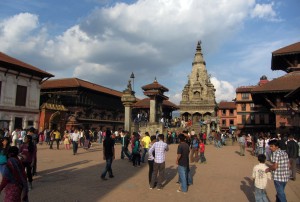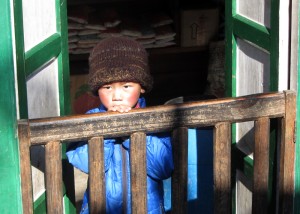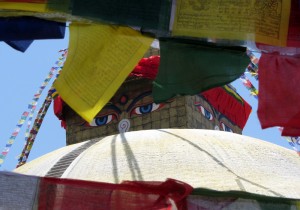“Madam, are you happy today?” asked the tour guide who had been stalking me for the last ten minutes. Standing in Durbar Square in the tourist city Bhaktapur, this is no strange occurrence. Yet a “no” or an “I’m not interested” response does not shake these salesmen (boys, really). The Nepali continues his fight to make the sale, saying, “Talk is free madam.” I think to myself, your talk is not free because you are taxing my brain, so no, I am not happy.
In a nation where one-fourth of the workforce is working outside of the country to create decent lives for their families, people earn a rupee any way they can. Agriculture, tourism, and service industries are the main sources of income in the country. A wealthy family lives well on US$6000 per year. An impoverished, farm family struggles on US$800 per year.
Despite the economic challenges, Nepal is easy to like, especially the northern area which contains the Himalaya range. However, this beautiful place caused us a few headaches as well. Roughs roads, electricity shortages, frequent political strikes, and constant noise, just to name a few. We took the bad in stride and really enjoyed the good when it came along.
Nepal surprised us by being more like India than the tour photos lead you to believe. All those ruddy, chubby-cheeked faces are Tibeatan Nepalis, about one-third of the population. The rest of the people are native Nepalis of various clans and a mix of Indian and Nepali ancestors. Many women wear saris, almost 60% of Nepalis are Hindu, and cows still wander the streets… thankfully in far fewer numbers than India.
Where Nepal is truly its own nation is in the food. Well, one dish actually, daal baht. As I mentioned in our Everest food video, daal Baht is eaten twice a day, every day, by over 80% of the population. Even when given other mealtime choices, Nepalis prefer their national dish. The plate is half-filled with white rice, a quarter with curried vegetables and a quarter with stewed meat, if you are very lucky. Otherwise, more veggies, usually potatoes. On the side is served a very watery, spiced lentil soup.
Eating Nepali style, you pour your barely-enough-lentils soup over the rice and dig in. With your right hand. Mashing everything together, Nepalis scoop the food into their mouths, not stopping until the entire plate is gone. Day after day, lunch and dinner, lunch and dinner. It’s a tasty enough plate of food, yet sadly nutritionally deficient.
Power outages are a daily companion in this country. Most of the power comes from hydroelectric dams, yet it’s not enough, so load shedding happens on a daily schedule. Or not. While the city government tries to follow a timeline, citizens were reluctant to tell us when power would return, as they never really knew when it would. We spent many evenings by candlelight, flashlight, and computer glow, until the batteries ran out.
And when that wasn’t enough to crimp our day, political strikes or banda would pop up to keep us alert. Our visit coincided with a great deal of strife in the political system. Lack of a system, really: Nepal has been without a constitution for over three years. In 2009, the monarchy stepped down to allow the country to be governed democratically. The new constitution was supposed to be completed a few days after our departure, but the politicians couldn’t agree and missed the deadline… again. Citizens and various political groups often take to the streets, causing transportation, schools, and businesses to come to a stop. These strikes affected three days of our trip to Nepal, and many more occurred after we left.
Most of the locals we met were friendly and willing to answer questions, if they had the English skills. Kids in particular loved chatting with us and were especially helpful when we were lost. The only major downside is that Nepalis, like other southeastern Asians, don’t like to use the word no or give you a negative answer. Some interactions proved challenging, and I still have not mastered asking my questions to get a detailed answer. If you mention a potential answer, they will always agree with it. “Is it to the left?” “Yes, to the left!” Sigh.
Thankfully, we tempered some of the Nepali nuttiness with our time in The Bubble. Thanks again to our hosts, the marvelous Meeks family. Through their eyes we learned that living in Nepal for three years can be filled with joy, provided you have a nice home with running water and a generator to return to each day!
From hiking to see wild rhinos, squeezing in with the New Year’s Eve crowds, whitewater rafting between beautiful cliffs, gazing upon Mt. Everest, and contemplating our spirituality with Buddha Eyes everywhere, we truly enjoyed our five weeks in Nepal. So yes, dear tour guide hawker, I am happy today.






